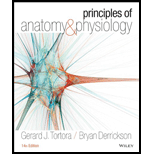
Compare the sizes and locations of the cerebrum and cerebellum.
To review:
The comparison between sizes as well as the locations of cerebrum and cerebellum.
Introduction:
The central nervous system (CNS) comprises the brain and spinal cord. The human brain constitutes of vesicles that make up five major components: telencephalon, diencephalon, mesencephalon, metencephalon, and myelencephalon. Cerebrum is considered as the largest and the most developed portion of the mammal's brain and it plays a key role in awareness, memory, thought, consciousness, and perception. The cerebellum is referred as the second largest portion of the brain that play an important role in primal feelings, language, attention, precision, and accuracy.
Explanation of Solution
Cerebrum and cerebellum are the parts of forebrain and hindbrain, respectively. A comparison between the cerebrum and cerebellum on the basis of their size and location is given below:
| S. no | Cerebrum | Cerebellum |
| 1. | It makes the largest part of the brain and consists of around 83% of the total brain mass. | It is the second largest part of the brain and forms around 11 % of the total brain mass. |
| 2. | It is a part of secondary vesicle that is telencephalon. | Cerebellum is a component of secondary vesicle metencephalon. |
| 3. | It is a part of prosencephalon (forebrain). | It is a part of rhombencephalon (hindbrain). |
It can be concluded that cerebrum is largest in size as compared to the cerebellum and it is located in the forebrain, whereas the cerebellum is located within the hindbrain.
Want to see more full solutions like this?
Chapter 14 Solutions
Principles of Anatomy and Physiology
- ✓ Details Draw a protein that is embedded in a membrane (a transmembrane protein), label the lipid bilayer and the protein. Identify the areas of the lipid bilayer that are hydrophobic and hydrophilic. Draw a membrane with two transporters: a proton pump transporter that uses ATP to generate a proton gradient, and a second transporter that moves glucose by secondary active transport (cartoon-like is ok). It will be important to show protons moving in the correct direction, and that the transporter that is powered by secondary active transport is logically related to the proton pump.arrow_forwarddrawing chemical structure of ATP. please draw in and label whats asked. Thank you.arrow_forwardOutline the negative feedback loop that allows us to maintain a healthy water concentration in our blood. You may use diagram if you wisharrow_forward
- Give examples of fat soluble and non-fat soluble hormonesarrow_forwardJust click view full document and register so you can see the whole document. how do i access this. following from the previous question; https://www.bartleby.com/questions-and-answers/hi-hi-with-this-unit-assessment-psy4406-tp4-report-assessment-material-case-stydu-ms-alecia-moore.-o/5e09906a-5101-4297-a8f7-49449b0bb5a7. on Google this image comes up and i have signed/ payed for the service and unable to access the full document. are you able to copy and past to this response. please see the screenshot from google page. unfortunality its not allowing me attch the image can you please show me the mathmetic calculation/ workout for the reult sectionarrow_forwardIn tabular form, differentiate between reversible and irreversible cell injury.arrow_forward
- 1.)What cross will result in half homozygous dominant offspring and half heterozygous offspring? 2.) What cross will result in all heterozygous offspring?arrow_forward1.Steroids like testosterone and estrogen are nonpolar and large (~18 carbons). Steroids diffuse through membranes without transporters. Compare and contrast the remaining substances and circle the three substances that can diffuse through a membrane the fastest, without a transporter. Put a square around the other substance that can also diffuse through a membrane (1000x slower but also without a transporter). Molecule Steroid H+ CO₂ Glucose (C6H12O6) H₂O Na+ N₂ Size (Small/Big) Big Nonpolar/Polar/ Nonpolar lonizedarrow_forwardwhat are the answer from the bookarrow_forward
 Fundamentals of Sectional Anatomy: An Imaging App...BiologyISBN:9781133960867Author:Denise L. LazoPublisher:Cengage Learning
Fundamentals of Sectional Anatomy: An Imaging App...BiologyISBN:9781133960867Author:Denise L. LazoPublisher:Cengage Learning Human Physiology: From Cells to Systems (MindTap ...BiologyISBN:9781285866932Author:Lauralee SherwoodPublisher:Cengage Learning
Human Physiology: From Cells to Systems (MindTap ...BiologyISBN:9781285866932Author:Lauralee SherwoodPublisher:Cengage Learning Anatomy & PhysiologyBiologyISBN:9781938168130Author:Kelly A. Young, James A. Wise, Peter DeSaix, Dean H. Kruse, Brandon Poe, Eddie Johnson, Jody E. Johnson, Oksana Korol, J. Gordon Betts, Mark WomblePublisher:OpenStax College
Anatomy & PhysiologyBiologyISBN:9781938168130Author:Kelly A. Young, James A. Wise, Peter DeSaix, Dean H. Kruse, Brandon Poe, Eddie Johnson, Jody E. Johnson, Oksana Korol, J. Gordon Betts, Mark WomblePublisher:OpenStax College





